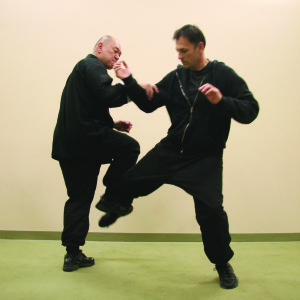If the internet has done anything, it has really expanded my Wing Chun training network. Although I have yet to take any wild trips around the globe and take advantage of Sifu’s I have spoken to, I did manage to interview a number of teachers who really impacted how I view the system and fighting in general.
I want to take advantage of the EWC blog and share what I learned. My goal is to compile some quick actionable items of the information I learned and share it with the Wing Chun world.
Here is what I learned:
A while with Sifu Mark Philips, who is one of the first Sifus I interviewed:
 He has one of the most popular Wing Chun Youtube channels at the moment and had a great time talking to him.
He has one of the most popular Wing Chun Youtube channels at the moment and had a great time talking to him.
I’ve always thought to myself “if people in the UFC or boxing shadow box/spar, why can’t we?”
Sifu Philips shared with me his thoughts about this type of exercise and even integrated it into his own training.
Here are his thoughts on what he refers to as “Shadow Sparring:”
“It is very different to shadow boxing. There is a number of ways you can approach. There are two ways I approach it in my own personal training. I like to train the machines of the movement, repeat a chain linked of actions with footwork. It is similar to doing your forms, but just breaking it up. I think at a higher level you kind of just “go” and figure out what each movement means.
Another way is to actually think about what you are doing. Not just sit there and go through it. Think to your self “okay, I do a bong – lop sau, and punch forward, is that person going to block it? Yes, they are, so I switch that into a lan sau, etc. When I lop, where are they likely to block?” In other words you can train for the mechanics, the physicality of the movement, which will help you link your body and comes in handy for Chi Sau. Then you can also train the conceptual side of it.”
Including myself, I think very often many of us fall into the trap of “my Sifu said this, so what my Sifu said is the only answer.” If you “shadow spar,” or simply practice in the air without a partner, it gives you time to think and discover new applications of the movements you studied. I by no means claim to be a great or wonderful Wing Chun practitioner, but my feeling is very simple.
If professional fighters have to take the time to shadow box to both mentally and physically figure out how their system works and how to apply it, why should we be any different?
Hitting stuff with Sifu Michael Quijano
 Speaking with Mike is always a blast. He has a “no nonsense attitude” when it comes to training. Being that Sifu Quijano has trained a number of different martial arts. During our conversation we mainly focused on his Thai boxing and Wing Chun training. One of the topics that came up was how he trains his Wing Chun and Thai Boxing students.
Speaking with Mike is always a blast. He has a “no nonsense attitude” when it comes to training. Being that Sifu Quijano has trained a number of different martial arts. During our conversation we mainly focused on his Thai boxing and Wing Chun training. One of the topics that came up was how he trains his Wing Chun and Thai Boxing students.
Here is what he said:
“Let’s put it this way, I condition my Wing Chun fighters like a Muay Thai fighter. We keep it strictly Wing Chun, but we use Thai equipment. We use the Thai banana bag, Thai bags, I have them work on their endurance. I strongly believe you have to be in shape as a fighter, you can’t rely on Wing Chun alone. This is the problem with a lot of teachers and practitioner’s right now. Endurance.”
I felt this was a great observation and something everyone should apply to their training. What I mean by this is that there are so many great training devices out there that can be easily applied to Wing Chun. From my own experience, training with boxing focus mitts and a punching bag will do wonders. Not only does your endurance increase, but you become stronger, faster, better hand eye coordination, the list can go on forever.
There is plenty of stuff out there for fighters to train with, as long as it supports Wing Chun’s fighting methodology, why not use it?
Pass a medicine ball with Sifu Robert Chu.
I had a really fun conversation with Sifu Chu, he is an interesting and knowledgeable practitioner. Being that he is an Acupuncturist, he has a really good understanding of human anatomy and how it applies to Wing Chun. Being that he knows how our body works, he is able to come up with a number of drills that can improve your Wing Chun from an anatomy/scientific perspective.
One thing he brought up was a simple partnered exercise with a medicine ball.
Here is what he told me:
“You have a 10 pounder, a 12 pounder, and a 15 pounder to start with. Have everyone warm up with them, have everyone do medicine ball drills. You can do it standing, shifting, from difference stances, and pass it to each other. You can change the distance from one another, it can be 10 feet, 12, feet, 20 feet. You can’t launch a ball 12 feet with your arms, you gotta use your stance.”
I thought this exercise was pretty interesting and it really forces you to engage your  core/stance. It is fairly simple to follow and it is something I have implemented into my training.
core/stance. It is fairly simple to follow and it is something I have implemented into my training.
From my understanding, another aspect you might want to take into account is that when you launch or throw the ball to your training partner you should try and perform a similar movement like the first move in Chum Kiu. I am referring to the very first movement where you simultaneously launch your hips and hands/fingers forward.
Personally, I can’t get enough of the medicine ball and there are so many great exercises you can do with it outside of Wing Chun. When I’m lacking a Wing Chun training partner, I go over to the park, find a nice wall, and apply the same type of movements Sifu Chu mentioned above. Basically, using Wing Chun movements to project the ball at the wall.
I hope you learned a thing or two from the conversations I had in the past. I am personally always interested to hear about how different people train, especially from teachers with years of experience. I’m NOT suggesting there are no other ways to train Wing Chun or that you absolutely must follow the advice of these different Sifus.
However, I do believe that things have changed since Ip Man started training and there is nothing wrong with using newer types of equipment to support our Wing Chun.
